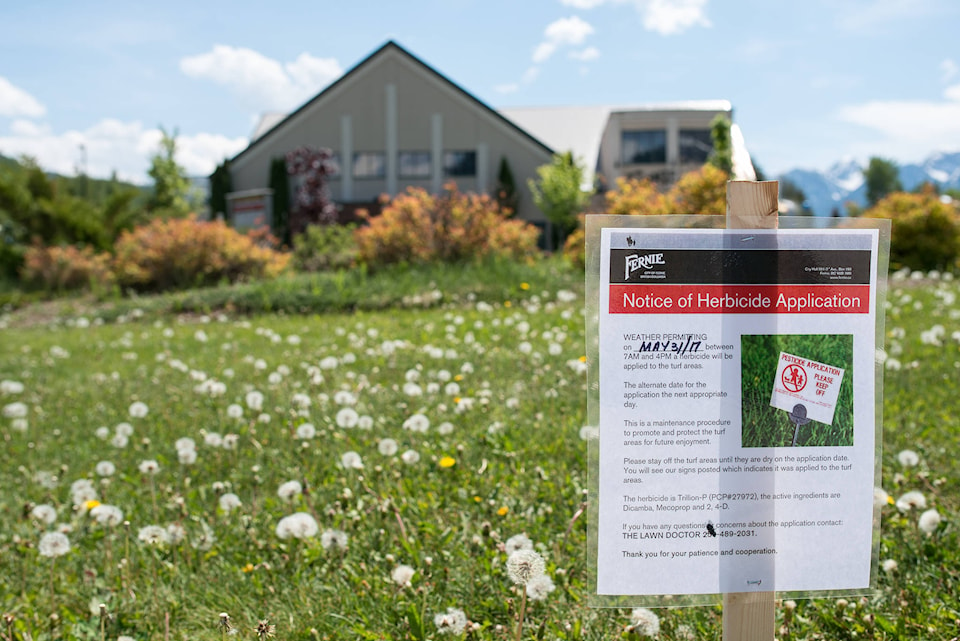In response to the City of Fernie’s plan to use herbicides to control weeds, local resident Ayla Bennett has started an online petition calling for the community to be kept herbicide free.
On June 11, it had 196 signatures.
“Spraying herbicides isn’t worth any possible risk to our children, pets or environment,” wrote Bennett, a scientist and local mother, on the online petition.
“Parks don’t have to be picture perfect at the expense of spraying toxins into the environment,” commented Erich Leidums, the founder of the Outdoor Connections Foundation.
“Dandelion and clover are harmless, even beneficial,” added Gaëtane Carignan. “This is a reckless use of taxpayer funding for a pointless cause. Harmful chemicals, costly (in more ways than one) for aesthetic purposes only? Not acceptable.”
During a Committee of the Whole meeting on May 23, the City of Fernie approved a one-time exemption to the Herbicide Use Control Bylaw No. 2093, to allow for the application of the herbicide to the city-owned property to control clover and dandelions. It was to use the herbicide Trillion-P (PCP#27972), which contains the active ingredients Dicamba, Mecoprop and 2, 4-D.
In a report to council director of Leisure Services Lloyd Smith said the city’s green spaces had become significantly infested with weeds. The City of Fernie had not used herbicides to control weeds on city-owned turf areas for over five years, he said, with the exception of their usage on the Max Turyk sports field in 2016.
The work was scheduled to take place from May 31 to June 2 at the City Hall Courthouse, the Fernie Aquatic Centre, Fernie Memorial Arena and Community Centre, Ridgemont Park, Silver Ridge Munroe Cemetery Grounds and James White Park, excluding the tennis courts.
However on May 31, the city announced it would not be proceeding with the work.
In a statement issued June 6, the city said it would not proceed with herbicide application in the future, until “a very robust and thorough communication process” occurs.
The city also argued that the goal of the herbicide application was for both cosmetic reasons and to control for noxious weeds.
“The current weed-infested turf creates ideal conditions for noxious weeds to thrive and imbedded weed clumps create safety hazards,” said the statement. “This application of (herbicide) would be aimed at deterring the growth of all weeds and would be done in conjunction with a program of aeration, fertilizer, top dressing, and other best practice turf management procedures.”
“Some of the areas planned to be sprayed with (herbicide) already have noxious weed growth present, other areas are at risk of noxious weed growth due to the poor state of the turf related to the significant amount of general (non-noxious) weeds present. By building up turf health, it is expected that ultimately noxious weed growth will be diminished and the safety of field users will be increased,” it continued.
The city encouraged residents with concerns or suggestions related to herbicide use, noxious weeds, and turf safety to express their concerns by emailing the city at cityhall@fernie.ca
The herbicide 2, 4-D is produced by U.S.-based Dow AgroSciences LLC and was once sold widely throughout the country as a cosmetic lawn care product. It has since been banned for sale in certain localities because of suspected health risks.
A Government of Ontario website on the subject says the herbicide is banned for cosmetic use and sale in that province. The website defines it as a Class 9 herbicide, banned because it could pose a risk to human health, particularly children’s health.
A 2016 article published by an Amercian conservation group the Natural Resources Defense Council claims that 2,4-D has been shown to be an endocrine-disrupting chemical that is potentially cancer-causing.
In 2015, the World Health Organization (WHO) declared 2,4-D a possible human carcinogen, based on evidence that it can damage human cells and was observed to cause cancer in laboratory animals.
“The herbicide 2,4-D was classified as possibly carcinogenic to humans… based on inadequate evidence in humans and limited evidence in experimental animals,” said WHO in a statement.
Ryland Nelson Wildsight Southern Rockies program manager does not believe the city should proceed with the weed control project.
“If (the city) does require an exemption (of its bylaws), it should really make a strong case about why,” he said.
Nelson also believes the city acted in contravention of its bylaws.
In a statement from the city, signage was to be placed in the subject areas 48 hours in advance of any spraying and written notice was to be provided to adjacent home owners. After any herbicide application, signage was to remain in place for 72 hours, as per Bylaw 2093.
The city did not follow the process for the exemption as it didn’t provide 48 hours notice.
“The city has a problem with bylaw enforcement and trying to get people to follow their bylaws but even the city isn’t following its own bylaw,” he said. “Its not a very good example that they’re setting.”
